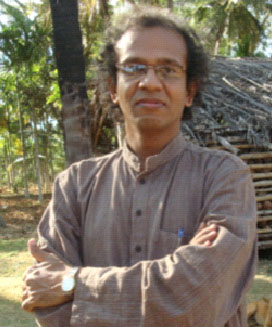India, for a long time, has had an extraordinarily rich and deep-rooted scholarships in all the domains. This has passed down in an academically sensitised set up. Unfortunately that class of scholarship is dwindling with generations passing by. Yet, we have a few exceptionally genuine scholars who have the scholarship in depth knowledge of the Bharatiya tradition. One such is Shatavadhani Dr R Ganesh.
Connection With Society
On his recent eventful completion of 60 years, it is a good occasion to visit the extraordinary scholarship he has pursued in the Indic knowledge system. Dr Ganesh has managed to touch all the classes of society through his discourses, with an array of 10,000 hours’ worth of talks which have dealt as varied topics as Spirituality, Veda, Vedanga, Darshana, Agama, Purana, Dharma Shastra, Artha shastra, Sahithya, Natya shastra, Itihasa and Kavya traditions of India. He has the uncanny ability to make his talks penetrative to the masses through a sharp intellect and critical analysis with anecdotes and use of idioms and popular phrases. Thanks to his discourses, much is available now in the public space about Vyasa, Valmiki, Bhasa, Kalidasa, Sudraka, Vishnu Sharma, Bartru Hari, Bharavi, Magha, Bhavbhooti, Bana, Pampa, Ranna, Kumaravyasa, Vidhyaranya, modern scholars such as PV Kane, Prof Hiriyanna, DV Gundappa, Devudu, Kuvempu, SL Bhairappa to name a few. faith in Bharatiya culture
According to Shashi Kiran, a young scholar who has closely been associated with Dr Ganesh in literary pursuits, the most important contribution through his discourses has been the sensitisation of the masses towards Bharatiya cultural, literary, and philosophical heritages. Incidentally, Shashi Kiran has co-translated a book with Dr R Ganesh, Mahabrahmna from Kannada to Sanskrit which has won the Kendra Sahithya Academy award for the year 2021.

The task of mastering classical learning and articulating the same in the contemporary context to the public is an arduous task. Dr Ganesh opines that the classical learning is more specific in comparison to the contemporary studies whose learning needs entirely focussed study understanding the language, vocabulary, grammar, and idioms of that era. That classical learning pursued by Dr Ganesh, for the last four decades, has been extensively researched through individual works as well as through the critical observations of the contemporary Indian writers. The latter is necessary, according to Dr Ganesh, to widen the horizon, something missing in those pursuing Master studies these days, thus limiting their broader vision in this domain.
Poetry with creativity
The one achievement of his that stands out, is in the creative poetry. It is noteworthy to note that before his entry to the literary scene in the second half of the 20th century in Karnataka, there was not much of interest to the poetry composition using the chandas (metre). Dr Ganesh introduced the creative aspects of poetry both in Kannada and Sanskrit. The poetic aspects should not be archaic or directionless but should be rooted and enriched in the Vedantic tradition of non-duality and Rasadhvani. One should not violate the time-tested universal aspects of the tradition. Sustainability is possible only through critical conservatism, the rules that he held firmly.
Performance at a glance
Dr Ganesh has performed around 1300 Ashtavadhana’s (involving eight scholars and poets) and 5 Shatavadhana’s (one hundred scholars and poets involved). The Avadhana art involves topics varying from Ramayana, Mahabharata, Bhagavat Geetha, Bhagavatha, from the works of poets of Kalidas, Shankara, Navarasa, Advaita to the works of modern era writers. His thesis titled Kannadadalli Avadhanaskale, about the Avadhana art form was awarded the D Litt degree from Hampi University. Subsequently, he authored several books about the art of Avadhana. Alongside reviving the art of Avadhana, he has also contributed in a unique and original way to music, dance, and theatre. He has materialised a novel art form called kavya-chitra-Gita-Nrutya, an amalgamation of poetry, painting, music, and dance. He has been guiding two to three generations of dancers performing Bharatanatyam, kathak, Kuchipudi in choreography, music, and dance directions. He has authored four hundred compositions for the nrutya-nataka. To popularise Indian classical music, he conceptualised Raganuraga, a musical programme through which 120 ragas were introduced.
Dr Ganesh has performed around 1300 Ashtavadhanas (involving eight scholars and poets) and five Shatavadhanas (one hundred scholars and poets involved)
A prolific writer, Dr Ganesh has written in Kannada, English and Sanskrit languages. Seventy different works have featured arts, literature, aesthetics, prosody, philosophy, history, mythology, and culture.
Expressing serious concerns about the lack of thoroughness and sparkling academic work in India, he cites lack of honesty and inter-disciplinary learning to be the reasons why there has been a decline in academic standards. This domain needs best brains to extend the horizon of shastra to produce seminal work. It is not possible for governments to extend all the support; private initiatives should support the serious workers in this domain to make it attractive for more motivated and committed individuals to enter therein that he emphasised upon.
It is extremely important to expose children to the epics of Ramayana and Mahabharata and train the teachers to rekindle interests in our traditions to shape up the next generation. The four decades of outstanding scholarly works of Dr Ganesh are a beacon of hope for the next generation to follow through.

















Comments